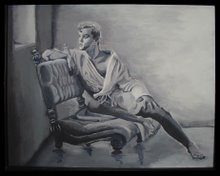
Once again I’ve found a beautiful piece of Randall Good’s work that deserves mention here on the blog. Of course, I would love to review each and every piece of work that he creates, but that would be a little time consuming. This piece is a drawing I acquired for a friend’s birthday present. He admired it at the last gallery walk we attended at Blue Moon Art Gallery in Hot Springs. I generally need very little excuse or persuasion to buy Randall’s work. I love it all.
This piece was untitled but I’m sure it could be called, “Christ Victorious”, or “Christ Triumphant”. Another interpretation might be a highly stylized ascension. The work is a graphite and white chalk drawing on a gray tinted paper support. Once again, Randall left a beautiful white deckled edge lending to the suggestion of an old parchment. The sense of Michelangelo’s or Da Vinci’s Renaissance works is prevalent again. This work was floated over gray mattes to compliment the tone of the support. The fully framed dimensions are 14X21 inches.
This work is a striking composition and succeeds on a number of artistic levels. As a balanced composition it appeals because of the contrasting elements of the organic and dynamically posed body countered by the static and geometric form of the cross. The drapery is energetic and wind-swept while serving a primarily decorative and ornamental purpose. The dominance of the cross in the upper left quadrant is countered nicely by an abundance of twisting fabric held in Christ’s hand and in the lower right corner. Randall’s sense of line and movement gives the viewer’s eye a number of paths to follow through the work. The lovely S-shaped serpintinato of the body projects upward, the diagonal of the cross moves left to right, the billowing curvature of the drapery encircles and frames the figure. It all works together to create a vigorous amount of activity in what could be a very static and stationary posed figure. One is reminded of Michelangelo’s David when looking at the bent knee and counterbalanced angled hip.
In analyzing the work one must question its purpose and meaning. At its essence, is this a spiritual work or a decorative one? Is this a religious work celebrating Christ or is it an ornamental work using the imagery of the Christ figure as decoration? Could it perhaps be both? Most religious works display the Christ figure for the purpose of narrating the His message and ministry. The crucifixion describes the story of the Passion. The resurrection shows His victory over death. The ascension demonstrates His separation from earth and habitation of heaven as a divine being. But, this work causes us to question which event is being portrayed. What is the story or message here? Is it simply a tribute to Christ as a physical being?
In this work, Christ is not nailed to the Cross. He embraces it as a symbol. Without it the viewer would be hard pressed to identify the figure as Christ. Perhaps this is an interpretation of the Resurrection. The billowing drapery might be the linens used to wrap His body. In the powerful force of reanimation He is liberated from them and they become more symbols of His victory and defiance over death. However, the drapery does little to cover the nudity of the figure and serves an accessory to stylize the work. The figure stands on a swath of the billowing fabric as if He is being elevated by wind alone giving Him a light and ethereal presence.
When looking at the image it gives the feeling of celebration and joy. This figure, without the cross, could easily be the triumphal top of a modern-day athletic trophy. The pose is not unlike the victorious Athena Nike with the uplifted arms ascending into the air. All that is missing is the wings.I like that this piece provokes questions in the mind of the viewer. I like that Randall didn’t do all of the mental work and storytelling for us. He intelligently creates an image that allows the viewer to bring their own interpretation and overlay it on the beautiful template he provides, thus creating an individual meaning for everyone who sees it.



